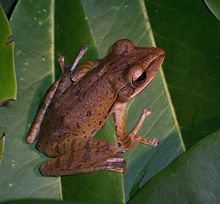Polypedates leucomystax
| Polypedates leucomystax | |
|---|---|

| |
| Scientific classification | |
| Domain: | Eukaryota |
| Kingdom: | Animalia |
| Phylum: | Chordata |
| Class: | Amphibia |
| Order: | Anura |
| Family: | Rhacophoridae |
| Genus: | Polypedates |
| Species: | P. leucomystax
|
| Binomial name | |
| Polypedates leucomystax (Gravenhorst, 1829)
| |
| Synonyms[2] | |
| |
The Java whipping frog, bamboo tree frog, jar tree frog, brown tree frog, common tree frog, common Indian whipping frog, Malayan house frog, four-lined tree frog, common tree frog, or stripe tree frog (Polypedates leucomystax) is a frog. It lives in India, Nepal, Myanmar, China, Singapore, East Timor, Japan, Cambodia, the Philippines, Thailand, and Bangladesh. People have seen it below 3,000 meters above sea level.[2][1][3]
The adult male frog is about 50 mm long from nose to rear end and the adult female frog is 80 mm long. The skin of the frog's back is brown, brown-yellow, or red-brown in color. Most frogs have some markings on their backs.[1]
This frog can live in many different places, including gardens.[3]
Scientists say this frog is not in danger of dying out because it lives in such a large place and because it is good at living in places that humans have changed.[3]
There is a subspecies: the white-lipped tree frog (Polypedates leucomystax leucomystax).[2]
References[change | change source]
- ↑ 1.0 1.1 1.2 Gary Tsai (October 24, 2005). Kellie Whittaker; Michelle S. Koo (eds.). "Polypedates leucomystax (Gravenhorst, 1829)". AmphibiaWeb. University of California, Berkeley. Retrieved February 2, 2024.
- ↑ 2.0 2.1 2.2 Frost, Darrel R. "Polypedates leucomystax (Gravenhorst, 1829)". Amphibian Species of the World, an Online Reference. Version 6.0. American Museum of Natural History, New York. Retrieved February 2, 2024.
- ↑ 3.0 3.1 3.2 IUCN SSC Amphibian Specialist Group (2023). "Java whipping frog Polypedates leucomystax". IUCN Red List of Threatened Species. 2023: e.T73729553A63882856. doi:10.2305/IUCN.UK.2023-1.RLTS.T73729553A63882856.en. Retrieved February 2, 2024.

